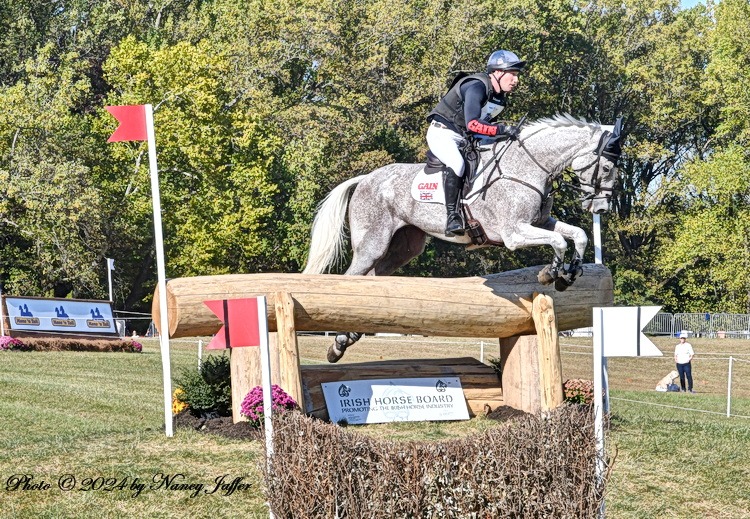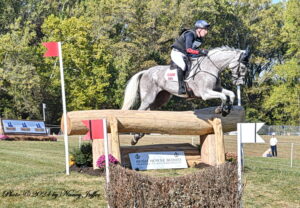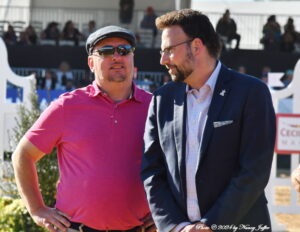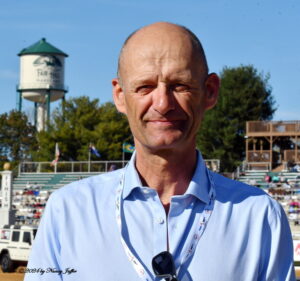The MARS Maryland 5-star made a big leap in quality for its third year in 2023, then burnished the details in 2024.
“Every year, we just constantly try to figure out, `How do we tweak and adjust elements?’ ” said Terry Hasseltine, executive director of the Maryland Sports Commission,
Part of the effort is to “identify what worked really, really well, and then what is maybe a sticking point so that we can address it next year.”
One issue that still requires work is increasing participation in the marquee portion of the weekend, the 5-star.
Some of the sport’s biggest names took part in the October event presented by Brown Advisory. The only downside was that the division drew just 23 starters, with a mere eight coming through from cross-country to the show jumping phase finale. The accompanying 3-star had 54 starters.
After a long season, the autumn is a difficult time for a test as stern as a 5-star to attract a large number of competitors in America. Meanwhile, though, the final 5-star of the year, France’s Pau on the weekend after Maryland, had a starting field of 71, but just three horses from the U.S. entered. The conditions of the two events drew a sharp contrast. Maryland, usually known for its good footing, had very hard ground after a record-setting drought; Pau was lashed by storms and the cross-country footing was slick muck.
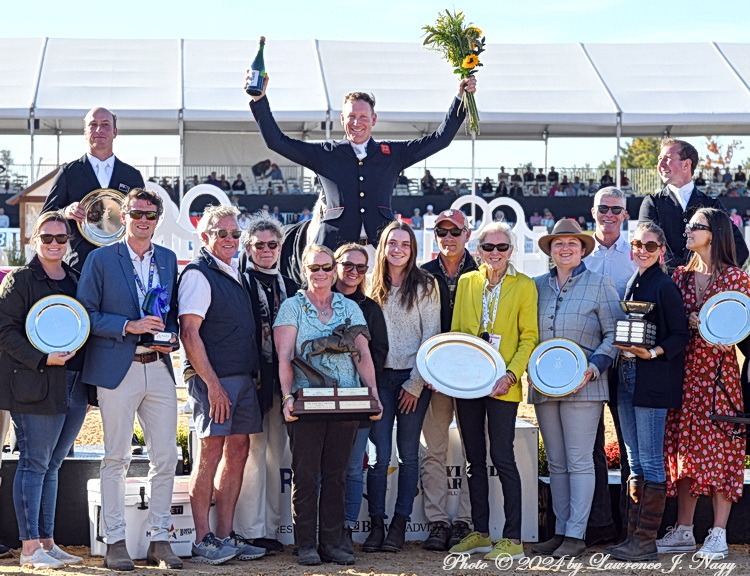
MARS Maryland 5-star winner Oliver Townend with runner-up Tim Price, left, and third-place David Doel, all of whom shipped over from Britain. (Photo © 2024 by Lawrence J. Nagy)
New Zealander Tim Price, who flew over from England to finish second at Maryland with his Olympic mount, Falco, said, “We love coming over here, and we’ll do what we can to encourage more people to come here, because it’s a fantastic event, definitely one of the best events in the world and we want to pump it up. So we’ll do what we can.”
Oliver Townend, the winner with Ballaghmor Class, is another who traveled from Britain to compete. He has been to each Maryland renewal and never ceases to praise it effusively.
About the entry situation he said, “It’s a percentage game at the minute, trying to fill this event up.”
He emphasized that Maryland, “really give the feeling of an exceptional event, and an event that’s going to be right up there with the very best in the world.”
Terry reported that organizers are “having good conversations” with the U.S. Equestrian Federation and the FEI (the international equestrian federation) “about what are some of the strategies we can implement together to insure the 5-stars — not just us, but (also) the others — are positioned on the calendar the right way, so there’s not conflict and challenges for some of the premier riders to have to make really tough decisions.”
The bottom line?
“To insure the vitality of this event can continue to move in the right direction. In the U.S. in the fall, it’s always going to be a unique challenge, no matter who hosted it. Multiple pro sports all kicking in; the change of seasons is coming along, you’re dealing with variations of weather systems. We’ve just got to keep making our product a bucket-list product people want to come out and see. not just in the equestrian space but in the general population.”
This was the first year that betting was allowed for the 3- and 5-star events via a partnership with Crab Sports, a startup sportsbook tailored for the Maryland market.
Maryland CEO Jeff Newman had said the idea was to create more off-competition amenities that would appeal to non-equestrians. He characterized its debut as sort of a beta test.
In regard to the cross-country footing, Terry said nearly 250,000 gallons of water were dumped on the course, “but it all got absorbed into the lower basin. Sometimes it hardens the ground more than softens it.”
The team is working on doing things before cross-country, such as dumping sand on the course “so it holds a little bit more water. There are turf recommendations being looked at so we can soften some areas when we do not have mother nature’s support.”
This year’s edition was supposed to be the last hurrah for Ian Stark, who has designed the cross-country course since the event began. But word of his retirement has been exaggerated, it seems. Paris Olympics course designer Pierre Le Goupil, who was named to replace Ian, has decided he doesn’t want to start out alone on that project. So Ian will be mentoring him at Maryland in 2025.
Pierre asked for Ian’s help, telling me he has never designed a 5-star; the Olympic cross-country is at 4-star Long level. On his first visit to the event, he found everyone “wonderful and welcoming.”
The Frenchman and Ian spent time together on the course, “sharing ideas and impressions. He noted, “it’s been an interesting and learning week for me.”
Pierre explained this month was a little bit early for him to make a plan for 2025. He took advantage of “more time for me to discover and know the people and how it works, the fantastic building team behind Tyson (Rementer, head of the course building effort.).
“It’s so important to feel the atmosphere of a venue before you even start to work on it. I’ve been taking a lot of information and need to digest a little bit,” he commented.
“It is not an easy venue, that is crystal clear, because of the hills and the extensive organization of the three different areas, with the racing field, including the main arena; the area by the crab water jump and that quite long and hilly pathway in between with ups and downs that you can’t avoid. It’s a challenge how to make it different every year without creating a revolution, without losing the benefit of the previous experience for everybody, the organization and also the riders. There’s a lot to learn and I’m very excited. I have fresh eyes, I have ideas and I need to put everything in order.”
Although the event is near the site of the Fair Hill International event that began in 1989, the 5-star venue is quite different. The arenas rather unusually are set in the middle of a turf racetrack, where thoroughbreds finally will run, beginning on Memorial Day weekend next year.
“It’s an awesome venue, but it’s pretty unique. There are things about it that are really tricky operationally,” said Competition Director Joanie Morris.
She noted the event was put together with, “a lot of new ideas and ingenuity. It takes a long time to develop and establish it. The first couple of years, it was just trying to sort that out.”
But by Year Four, “It feels very real now. It feels really established. A lot of people who I have a lot of respect for, who have been to a lot of events for a lot of years around the world, have said how good it is.
“Now we’re at the point where, what can we continue to do, what can we do better? And we’re looking forward to next year.”
She added with a grateful smile, “That’s not always the way you feel when you finish an event.”

